Mexican Mint

 The oldest mint in the Americas - producer of the Libertad coins
The oldest mint in the Americas - producer of the Libertad coins
The Mexican Mint ("La Casa de Moneda de México") is the official mint of the Republic of Mexico. It is the oldest mint on the American continents and produces the country's circulation and commemorative coins for the Bank of Mexico as well as various medals. The Mexican Mint produced various gold bullion coins throughout its history like the Mexican Centenario, Azteca and Hidalgo gold coins. Nowadays, it is the Mexican Libertad coins out of gold and silver that the mint is known for among bullion investors worldwide. The mint's ancient headquarter in Mexico City is nowadays a museum. All the coin production takes place at state-of-the-art facilities in San Luis Potosí.
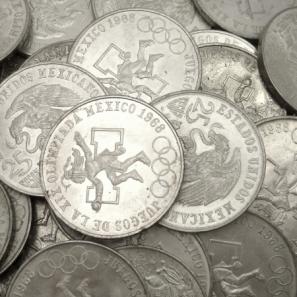
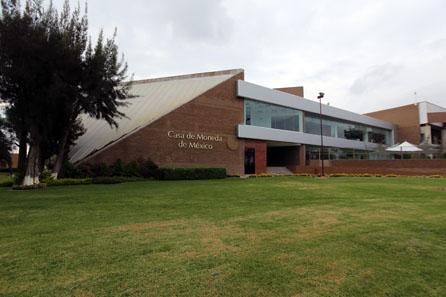
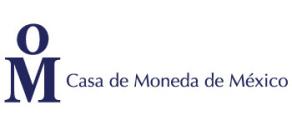
Minting Facilities
The historic headquarter of the Mexican Mint in a colonial-era building in Mexico City has become the National Museum of Cultures ("Museo Nacional de las Culturas") in 1966. The museum can be visited from Tuesday to Sunday (10 am to 5 pm) and admission is free of charge. It is located inside Mexico City's historic center (official address: Moneda No. 13, Centro Histórico, Deleg. Cuauhtémoc, C.P. 06010 México, D.F.) in close proximity to the Zócalo metro station. Many other landmarks of historical significance like the Palacio Nacional, Catedral Metropolitana and Museo de la Secretaría de Hacienda y Crédito Público are located in the same area.
The current production facility of the Mexican Mint is located in San Luis Potosí since 1992. The mint is housed there inside a modern building and uses state-of-the-art equipment. The facility can be visited and a visit starts with the spacious lobby where the mint's products are prominently displayed.
History
The first mint in what is now Mexico (then "New Spain") was founded in 1535 at a site where the Palacio Municipal now stands. In 1569, the mint moved to the Palacio Nacional. Private entrepreneurs rented the minting rights during the 17th and 18th century. These subsidiary mints once existed all over Mexico, normally close to silver mines which were abundant throughout the country.
The Mexican Mint started operations in its first exclusive building in 1734. The practice of renting out minting rights ended in 1778 when royal reforms put the Mexican Mint under the control of the Ministry of Finance. By then, the mint had already been modernized. The colonial-era building that then housed the Mexican Mint is now the National Museum of Cultures ("Museo Nacional de las Culturas").
In 1850, minting operations moved to Apartado Street in Mexico City. Still, Mexico's coin production couldn't keep up with increasing demand in the 19th century, resulting in the outsourcing of a part of the coin production to foreign mints (for example to the United States Mint in Philadelphia). In 1905, Mexico started an initiative to upgrade its minting operations. With the help of new machines and the extensive training of its workers, the Mexican Mint was soon able to produce all the needed coinage without the help of foreign mints a few years later.
Since 1986, the Mexican Mint competes on the market as a private mint and is no longer under control of the finance ministry. The current modern mint facility opened in San Luis Potosí in 1992.
The Mexican Mint's Gold Bullion Coins
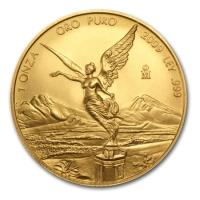
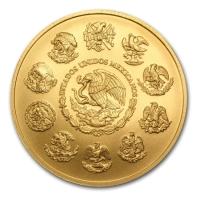
Mexican Gold Libertads
The Mexican Gold Libertad coins are struck out of 99.9% pure gold since 1981. Their design that depicts the Angel of Independence is inspired by the historic Mexican Centenario gold coins. The Gold Libertads are minted by the Casa de Moneda de México, the oldest mint in North America, in the denominations of 1 oz, 1/2 oz, 1/4 oz, 1/10 oz and 1/20 oz. Both brilliant uncirculated and proof coins are available. The coins don't have an official face value and their annual mintage numbers are much lower than those of other gold bullion coins. Despite that, the coins have legal tender status in Mexico.
The Mexican Gold Libertad page gives more information about the coins and allows you to compare current prices.
The Mexican Mint's Historic Gold Coins
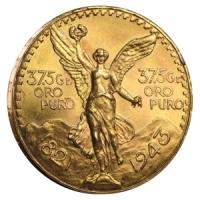
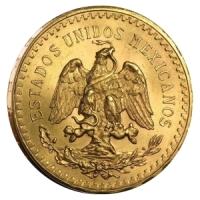
Mexican Centenario Gold Coins
The Casa de Moneda de México produced the Mexican Centenario gold coins between 1921 and 1947. The name Centenario comes from their dedication to the 100th anniversary of Mexico gaining its independence from Spain, its former colonial master. The coins are composed of 90% gold and 10% copper and have an actual gold weight of 1.2057 oz and a 50 Peso face value. With a diameter of 37.1 mm, the Mexican 50 Peso gold coins are the largest and heaviest of the different Mexican gold coins. Their obverse side shows Mexico's Angel of Independence with a laurel wreath and broken chains. An eagle perched on top of a prickly pear cactus holding a serpent can be seen on the reverse.
The Mexican Gold Centenario page gives more information about the coins and allows you to compare current prices.
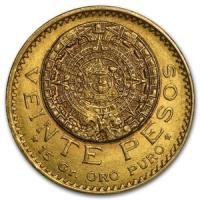
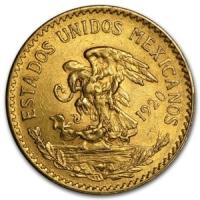
Mexican Gold 20 Pesos
Many investors and collectors consider the intricately designed Mexican Gold 20 Pesos to be one of the most beautiful gold coins of all time. The Casa de Moneda de México produced them between 1917 and 1921 and in 1959. The coins that are nicknamed 'Aztecas' are considerably smaller than the 'Centenario' Mexican 50 Peso gold coins. The Mexican 20 Peso gold coins are composed of 90% gold and 10% copper and have an actual gold weight of 0.4823 oz. A total of 6,174,000 such coins were minted. The obverse side of the coins shows the Aztec Calendar Stone. The rendering of the eagle & snake design on the reverse is different from that on the Centenarios.
The Mexican Gold Azteca page gives more information about the coins and allows you to compare current prices.
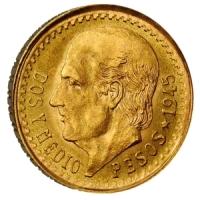
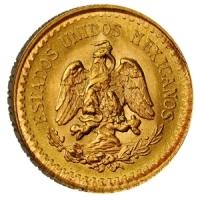
Mexican Gold Hidalgo
The Casa de Moneda de México produced the Mexican Gold Hidalgo between 1905 and 1959 in the denominations of 10 Peso (0.2411 oz), 5 Peso (0.1205 oz), 2.5 Peso (0.0603 oz) and 2 Peso (0.0482 oz). Not all denominations were minted in every year and there were various mintage interruptions during this period. The coins are composed of 90% gold and 10% copper. The four smallest denominations of the Mexican Gold Pesos are named after Don Miguel Hidalgo y Costilla whose portrait appears on the obverse of all except the 2 Peso coins. The reverse of the coins shows an eagle on top of a cactus holding a serpent, just like on the Centenarios.
The Mexican Gold Hidalgo page gives more information about the coins and allows you to compare current prices.
Other Precious Metal Bullion Coins
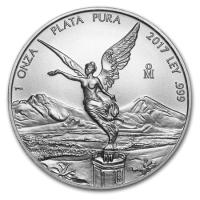
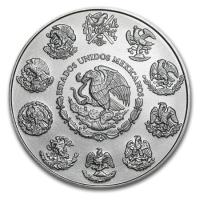
Mexican Silver Libertads
The Mexican Silver Libertad coins are struck out of 99.9% fine silver since 1982 by the Casa de Moneda de México. The coins bear the same design of the Angel of Independence as the Mexican Gold Libertad coins. That design originated with the historic Mexican 50 Peso gold coins. Silver Libertads are issued in many different sizes ranging from 1/20 oz all the way up to 1 kg. The coins don't have an official face value but are nevertheless legal tender in Mexico. Brilliant uncirculated, proof, reverse proof and antiqued coins are available. Compared with other silver bullion coins, proof coins make up an unusually large share of the total mintage of the coins. Three types of finish exist for the 1 kg coins (brilliant uncirculated, proof-like and high relief proof-like).
The Mexican Silver Libertad page gives more information about the coins and allows you to compare current prices.
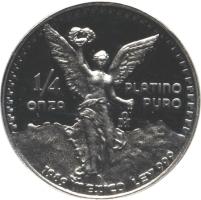
Mexican Platinum Libertad
The Mexican Platinum Libertad was only minted in the year 1989. That year, the Casa de Moneda de México produced 3,500 Platinum Libertads out of 99.9% fine platinum. Mintage was limited to a single denomination of 1/4 oz. These coins were only available with a proof finish. The design of both sides of the coins was identical to the gold and silver version of the Libertad coins that was minted until 1994.
The inscription on the mintmarked obverse side of the coins with the Angel of Independence reads: 1/4 ONZA PLATINO PURO 1989 MEXICO LEY 999.